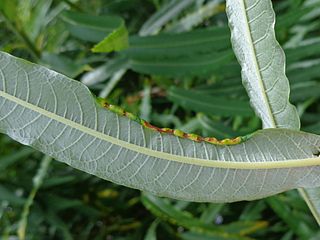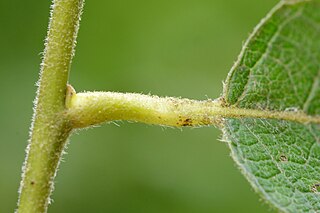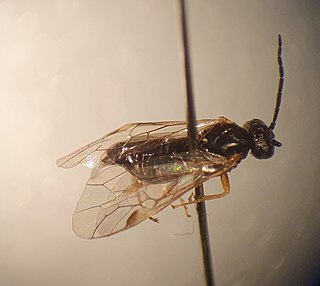
Rabdophaga rosaria is a gall midge which forms Camellia galls or terminal rosette gall on willow species. It was first described by Hermann Loew in 1850.

Dasineura crataegi, the hawthorn button-top gall-midge, is a dipteran gall-midge. It causes the hawthorn button-top gall, which develops in the terminal shoots of common hawthorn, Crataegus monogyna Jacq., Midland hawthorn C laevigata (Poir.) DC and their hybrid, C × media Bechst. Synonyms are Perrisia crataegi and Cecidomyia crataegi.

Hartigiola annulipes is a species of midge fly in the family Cecidomyiidae, found in the Palearctic. The fly was first described by Theodor Hartig in 1839. The larvae gall the leaves of beech.
Rabdophaga clavifex is a gall midge which forms galls on the buds of willow species.

Rabdophaga salicis is a gall midge which forms galls on sallows. It was first described by Franz von Paula Schrank in 1803.
Rabdophaga dubiosa is a gall midge which forms galls on the young shoots of willow.
Dasineura auritae is a gall midge which forms galls on the leaves of sallows and their hybrids. It was first described by Ewald Heinrich Rübsaamen in 1916.

Rabdophaga marginemtorquens is a gall midge which forms galls on willows and is found in Europe. It was described by Johann Jacob Bremi-Wolf in 1847.
Rabdophaga clausilia is a gall midge which, depending on the source, forms galls on the leaves of willows, or is an inquiline living in the galls of a Rabdophaga species, or a predator. It was first described by Johann Jacob Bremi-Wolf in 1847.

Euura venusta is a species of sawfly belonging to the family Tenthredinidae. The larvae feed within the leaf-stalk of willows forming a gall. The sawfly was first described by Carl Gustav Alexander Brischke in 1883.
Euura testaceipes is a species of sawfly belonging to the family Tenthredinidae. The larvae feed within the leaf-stalk (petiole), or midrib of a leaf, on willows forming a gall. The sawfly was first described by Carl Gustav Alexander Brischke in 1883. E. testaceipes is one of three closely related species known as the Euura amerinae species subgroup. The other members of the group are E. amerinae and E. venusta

Iteomyia major is a gall midge which forms galls on willows. It was first described by Jean-Jacques Kieffer in 1889.

Rabdophaga nervorum is a gall midge which forms galls on the leaves of sallows. It is found in Europe and was first described by the French entomologist, Jean-Jacques Kieffer in 1895.

Euura proxima is a species of sawfly belonging to the family Tenthredinidae. The larvae feed on the leaves of willows, creating galls and was described by Jean Guillaume Audinet-Serville in 1823.
Euura bridgmanii is a species of sawfly belonging to the family Tenthredinidae. The larvae feed on the leaves of sallows. It was first described by the entomologist Peter Cameron in 1883.
Dasineura fraxini is a gall midge which forms galls on the leaves of ash. It was first described by Johann Jacob Bremi-Wolf in 1847.
Dasineura acrophila is a gall midge which forms galls on the leaves of ash. It was first described by Johannes Winnertz in 1853 an is found in Europe.
Massalongia rubra is a species of gall midge which forms galls in the leaves of birch. It was first described by the French naturalist and entomologist, Jean-Jacques Kieffer in 1890 and is found in Europe.

Harmandiola tremulae, the aspen leaf gall midge, is a species of gall midges in the family Cecidomyiidae.











